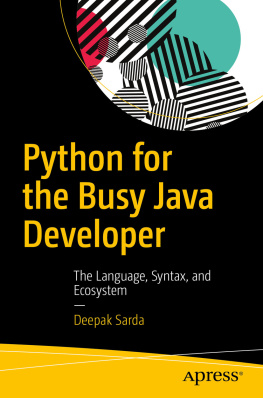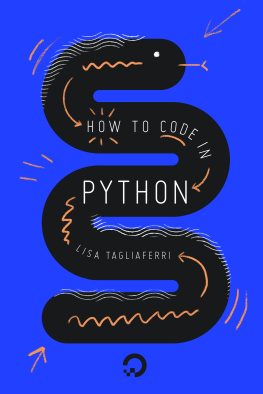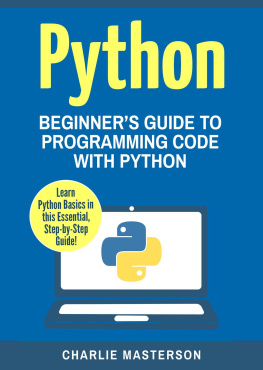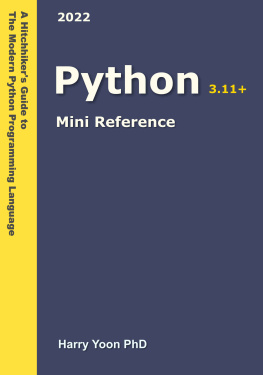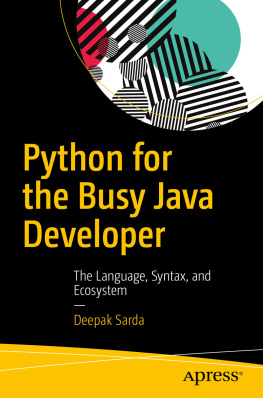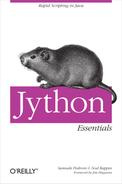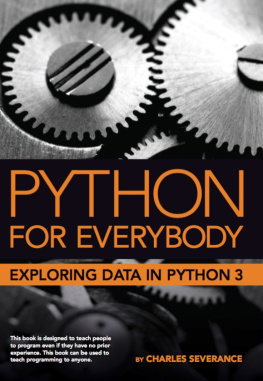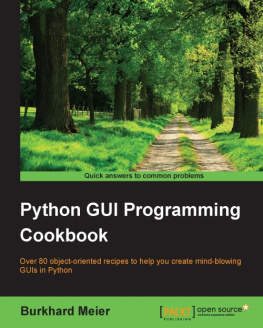Deepak Sarda - Python for the Busy Java Developer: The Language, Syntax, and Ecosystem
Here you can read online Deepak Sarda - Python for the Busy Java Developer: The Language, Syntax, and Ecosystem full text of the book (entire story) in english for free. Download pdf and epub, get meaning, cover and reviews about this ebook. year: 2018, publisher: Apress, genre: Computer. Description of the work, (preface) as well as reviews are available. Best literature library LitArk.com created for fans of good reading and offers a wide selection of genres:
Romance novel
Science fiction
Adventure
Detective
Science
History
Home and family
Prose
Art
Politics
Computer
Non-fiction
Religion
Business
Children
Humor
Choose a favorite category and find really read worthwhile books. Enjoy immersion in the world of imagination, feel the emotions of the characters or learn something new for yourself, make an fascinating discovery.
- Book:Python for the Busy Java Developer: The Language, Syntax, and Ecosystem
- Author:
- Publisher:Apress
- Genre:
- Year:2018
- Rating:5 / 5
- Favourites:Add to favourites
- Your mark:
Python for the Busy Java Developer: The Language, Syntax, and Ecosystem: summary, description and annotation
We offer to read an annotation, description, summary or preface (depends on what the author of the book "Python for the Busy Java Developer: The Language, Syntax, and Ecosystem" wrote himself). If you haven't found the necessary information about the book — write in the comments, we will try to find it.
Are you a seasoned Java developer who wishes to learn Python? Perhaps youve just joined a project where a chunk of system integration code is written in Python. Or maybe you need to implement a report generation module in the next sprint and your colleague mentioned that Python would be the perfect tool for the job. In any case, if you are in a situation where you have to pick up the Python programming language overnight, this book is just for you!
Hit the ground running and gain a fast-paced overview of what the Python language is all about, the syntax that it uses and the ecosystem of libraries and tools that surround the language. This concise book doesnt spend time on details from an introductory programming course or document every single Python feature. Instead, Python for the Busy Java Developer is designed for experienced Java developers to obtain sufficient familiarity with the language and dive into coding, quickly.
What Youll Learn
Discover the fundamentals of the core Python language and how they compare to Java
Understand Python syntax and the differences between Python 2.x and 3.x
Explore the Python ecosystem, its standard libraries, and how to implement them
Who This Book Is For
Working programmers who are comfortable with Java or another object-oriented programming language such as C#
Deepak Sarda: author's other books
Who wrote Python for the Busy Java Developer: The Language, Syntax, and Ecosystem? Find out the surname, the name of the author of the book and a list of all author's works by series.

